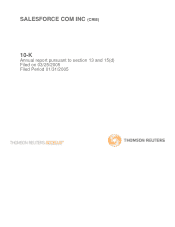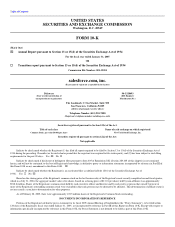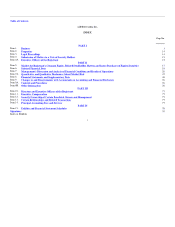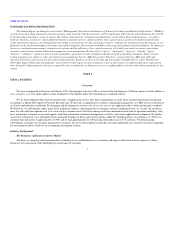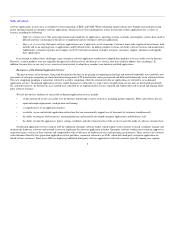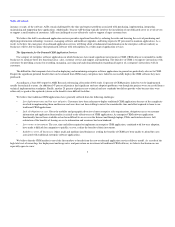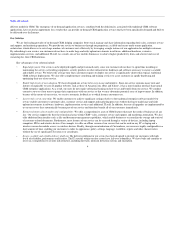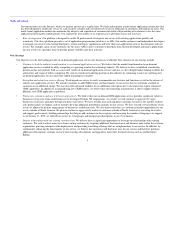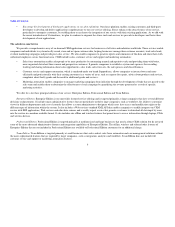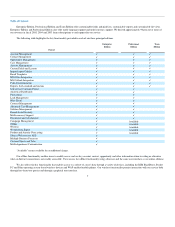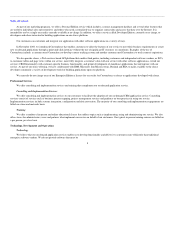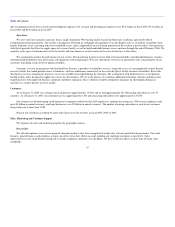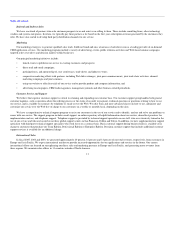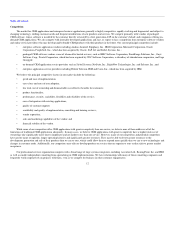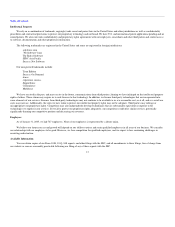Salesforce.com 2004 Annual Report Download - page 6
Download and view the complete annual report
Please find page 6 of the 2004 Salesforce.com annual report below. You can navigate through the pages in the report by either clicking on the pages listed below, or by using the keyword search tool below to find specific information within the annual report.
Table of Contents
instance, or copy, of the software, ASPs remain challenged by the time and expense problems associated with purchasing, implementing, integrating,
maintaining and supporting these applications. Additionally, because ASP hosting typically involves the installation of one dedicated server or set of servers
to support a small number of customers, ASPs are challenged to cost-effectively scale to support a larger customer base.
We believe the shift to on-demand application services provides significant benefits by reducing the risks and lowering the costs of purchasing and
deploying information technology resources, managing software and hardware upgrades, and hiring expensive IT personnel to maintain applications. As a
result, we believe the emergence of on-demand application services will bring about a fundamental transformation in the enterprise software industry as
businesses will be able to replace their purchased software with subscriptions to a wide range of application services.
The Opportunity for On-Demand CRM Application Services
One category of enterprise software applications in which businesses have made significant investments is CRM. CRM software is intended to enable
businesses to automate three key functional areas: sales, customer service and support, and marketing. The objective of CRM is to improve interactions with
customers by providing a means for recording, managing, accessing and analyzing information regarding all aspects of a company's interactions with its
customers.
The difficulties that companies have faced in deploying and maintaining enterprise software applications in general are particularly relevant to CRM.
Despite the significant potential benefits that can be attained from CRM, many enterprises have failed to successfully deploy the CRM software they have
purchased.
According to a June 2003 report by AMR Research referencing a December 2002 study, 12 percent of CRM projects failed to ever be implemented,
usually for technical reasons. An additional 47 percent of projects had significant end-user adoption problems even though the projects were successful from a
technical implementation standpoint. Finally, another 25 percent of projects met technical and user standards but did not provide value because they were
either only as good as the replaced systems or the benefits were difficult to define.
We believe that traditional CRM applications have generally suffered from the following challenges:
• Low deployment rates and low user adoption. Customers have been reluctant to deploy traditional CRM applications because of the complexity
involved in implementing them and because end users have not been willing to invest the considerable time and effort required to learn to use
traditional CRM applications.
• Lack of ubiquitous access. Given the mobility and geographic diversity of most enterprise sales organizations, ubiquitous access to customer
information and application functionality is critical to the effectiveness of CRM applications. As enterprise CRM software application
functionality has not been available or has been difficult to access over the Internet and through laptops, PDAs and wireless devices, full
realization of the benefits of sharing access to information and resources has been hindered.
• Low return on investment. The cost, time and effort required to implement an enterprise CRM application, combined with low user adoption,
have made it difficult for companies to quickly, or ever, realize the benefits of their investment.
• Inability to serve all businesses. Many small and medium-sized businesses seeking the benefits of CRM have been unable to afford the costs
associated with traditional enterprise software applications.
We believe that the CRM market is one of the first markets to benefit from the new on-demand application services delivery model. As a result of the
high total cost of ownership, low deployment and usage rates, and poor return on investment of traditional CRM software, we believe that businesses are
especially open to a new
3

